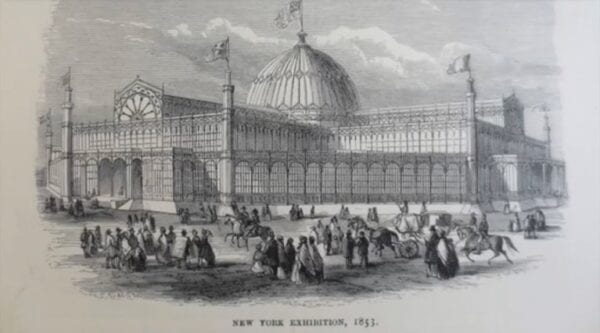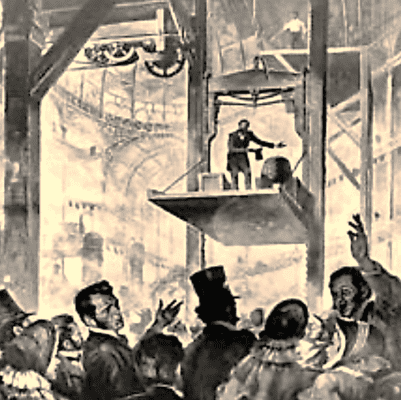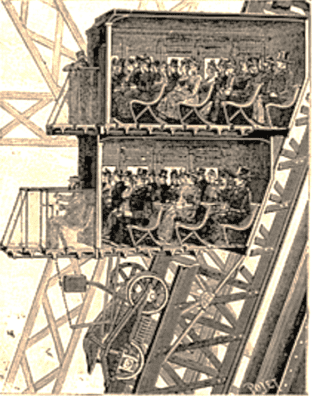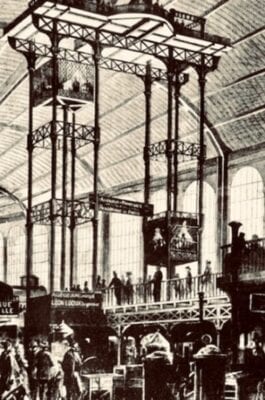by Bob McGlincy
Tradeshows have the power to establish a brand and energize a company. They can even revolutionize daily life. Want examples? Alexander Graham Bell first publicly demonstrated the telephone at the 1876 Centennial Exposition in Philadelphia. A century later, personal computers were first displayed at tradeshows in the late ‘70s, and early ‘80s. In both cases, it was to showcase new technology, and ultimately, to sell new product.
Another dramatic illustration of the power of tradeshows is the passenger elevator. While this choice may not be obvious at first glance, without safe passenger elevators, or some similar invention, the world as we know it would be very different today. Think about it: There probably would be no buildings over six or seven stories high; there certainly would be no skyscrapers.
The concept of a safe passenger elevator was first demonstrated at a tradeshow in New York City in 1854.

Three years earlier, Elisha Otis was tasked with cleaning a factory floor, and he wondered how he could easily move the debris to the upper levels of the warehouse. That same year, after returning from London, some power brokers in New York City wanted to emulate the Great Exhibition, and reproduce its success. They commenced building their own Crystal Palace in 1852, and 17 countries committed to exhibit. Unfortunately, the show did not open on schedule—much to the shock and dismay of the thousands who traveled expecting a May 2 opening.
The show opened July 14, two and a half months behind schedule. And even then, the building was not complete. The delays were caused by the Building Commission members arguing with the architects over designs, and insisting on changes which ultimately created delays and cost overruns. Partially due to the delayed opening, only 600,000 people attended the show in 1853, and receipts were way below projections. As far as profit, there was none, and the Board decided to extend the show.
To boost attendance, P. T. Barnum was hired to attract celebrities, add attractions and promote new products and exhibits. Barnum had been approached first in 1852. He declined, stating his opinion that it was too close in time to London’s exposition,

and the interest/attendance would not be there. But he accepted this time. He suggested installing new statues and artwork, brought attractions from his museum, promoted the steam washing machine, and recruited Elisha Graves Otis to display his new invention.
Otis invented the safety brake for an elevator. At the time, there were no passenger elevators, only freight ones, and workers were too scared to ride on the elevator with the freight. There were too many accidents with ropes failing and platforms falling. Some have said it was Barnum’s suggestion, but whether Otis thought of it first or not, here is what happened at the Exposition: Otis stood on a platform with freight, and had it hoisted in the air. He yelled, attracted a crowd, and said he was going to cut the rope to demonstrate the safety of his invention. Amid protests, and even some cheers from the crowd below, that is precisely what he did. The platform dropped only a few inches before the safety brake kicked in and the elevator stopped. The rest is history.
Otis sold safety brakes for freight elevators (the first foreign sale was in Scotland in 1856). The first passenger elevator in history was installed in a five story New York City department store in 1857. Prior to the first elevator, buildings were limited in heig

ht—and the top floors were less desirable, and less expensive to rent, than the lower floors (highest rents were street level). But that all changed.
Elisha Graves Otis died April 8, 1861, at the age of 49 (which sounds young, but the average life expectancy at the time was 45). His two sons, Charles and Norton took over the business. Understanding the importance and power of tradeshows, the Otis Brothers & Company exhibited at expositions in Paris in 1867, 1872, 1889 and 1900.

At the 1889 Exposition, Otis manufactured and installed elevators at the Eiffel Tower (in spite of the Fair’s initial stipulation that only French companies could be used in the construction of the Eiffel Tower). Despite a safe passenger elevator being demonstrated in Paris 22 years earlier, scores of journalists and others questioned its safety. So the company took a page from their founder’s playbook: they loaded the elevator with 6,600 pounds of lead, raised it halfway up, and cut the cable … not surprisingly, the safety brake kicked in, and the elevator stopped ten feet from the ground.
In 1900, the Otis Elevator Company (as it was renamed) installed the first escalator at the Paris Exposition of 1900. There are more than 2.6 million elevators and escalators worldwide; and they move over 2 billion people daily on Otis equipment.
At the first tradeshow where Elisha Graves Otis exhibited, the tradeshow lost money. However the company he founded did not lose money. Not even close. In 2019, Otis’ revenues exceeded $13.1 billion.
Tradeshows work. They work very well.
Bob McGlincy is director, business management at Willwork Global Event Services. Willwork creates engaging, energized, and exceptional event experiences. He can be contacted at Bob.McGlincy@willwork.com






























